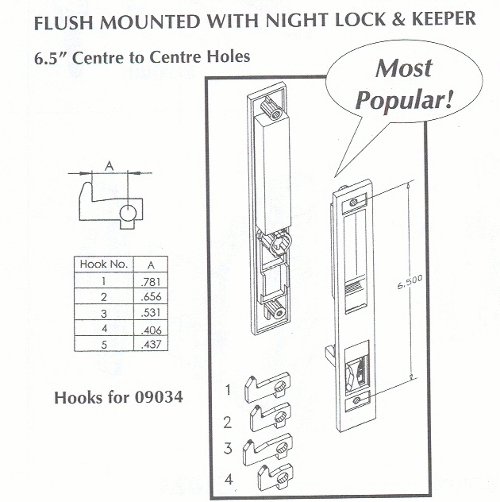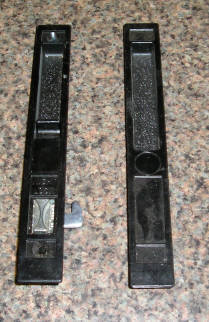Patio door latch for aluminum patio doors
- Home Page
- Aluminum Doors
- Patio Door Latch
The standard patio door latch found on most aluminum patio doors is what I like to call a "clamshell" style. The latch comes in 2 halves which fit on both sides of a large oval mortised hole cut right through the patio door frame. These locks are so thin, they wont interfere with drapes or blinds.
The latch is held together by 2 long machine screws installed from the inside on the top and and bottom on the latch frame. The two screws are spaced 6-1/2" inches apart. Most of the time these locks are installed on patio doors 1-1/4" thick but they can work with thicker doors just by using longer screws and offset latch hooks provided for the purpose.

These latches mostly come in black, but grey and chrome versions have been made, Black is by far the most common. There are also five different types of latch hooks available for these locks. You have to be careful to specify which latch hook you need.
The latch hooks can be installed both with the hook up, or down depending on the position of the keeper or strike used on your patio slider. There is also an offset hook used on thicker patio panels.

Beside the number of hooks, these locks also come in two different thicknesses, .094 and .187 as shown in the photo above.
The thinner .094 inch versions slide into the jamb when the panel is closed so if you substitute a thicker 0.187 inch one, the sliding panel wont close properly.
The .094 inch thickness lock is used with all patio doors thicker than 1.00 inch. The .187 inch thickness lock is used on thinner patio doors down to 0.800 inch thick.
Older versions of these locks used a gasket made of plastic or metal to make the lock thicker for use on doors thinner than 1 inch.
If you are at all confused, its best to send me pictures of your broken lock and I can make sure to send you the right parts.
 |
 |
Buy this patio door lock (Shipping Included in price)
Canadian Customers:
USA Customers:
Prices include shipping within the Continental USA and Canada. Please contact me for different latch hooks. Handles are available at extra charge, just let me know if you need them
Patio door latch handles
This patio door latch can be used as it is to open the patio slider as it has a built in pull but some people find it awkward to use. So you can get add on handles that attach to the latch frames.
The handles make it easier to open a heavy door . But Yes, you guessed it, there are several different types of handles !

The handle above is a low profile handle, it gives you something more to grab onto while still being low enough so it does not interfere with the drapes or blinds.
Like all the handles shown here, it just uses the same screws that hold the lock halves together. You may need a longer screw to use these handles.

The handle above allows you to grip the patio door latch with your whole hand for a more positive grip. It can get in the way of curtains and blinds depending how close they are to the sliding panels.
There are also optional lock cylinders that can be installed in this style of patio door latch. They are typically installed on the outside so you can unlock your sliding patio door. The one pictured below is the most common. There are two other lock cylinders available for thicker doors

Bear in mind that these latch assemblies are not terribly secure. Many burglars jimmy these types of latches just by using a large screwdriver to force the hook against the keeper and break it.
Nothing beats an old hockey stick or a piece of 1 x 2 as a first line of defense fit in between the operating panel and the side jamb of the sliding door.
Leave it there when you go out. It's next to impossible for a burglar to jimmy the panel open with the stick in place without resorting to smashing his way through the glass.
Not everybody likes the hockey stick latch so there are fancier products you can buy from the hardware store. The cheapest are pins which fit into a hole you have drilled through all your sliding panels.
Others are spring loaded pins you activate with your foot, which engage a hole you have drilled in on of the sliding panel bottom rails.
Another security technique is to add strips of wood to take up the gap between the top of the sliding panel and the top sliding door track. That stops the patio door from being lifted up which can unlock the door.
Screw a long strip of wood in place so that it does not interfere with the side to side motion of the panel but does not allow the panels to be lifted up and out without removing the wood strip.
Hardware stores also sell fancier shims for this purpose if you need something that looks a little more professional than a strip of wood.